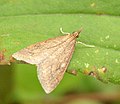| Crambidae | |
|---|---|
 | |
| Scoparia ambigualis | |
| Scientific classification | |
| Kingdom: | Animalia |
| Phylum: | Arthropoda |
| Class: | Insecta |
| Order: | Lepidoptera |
| Superfamily: | Pyraloidea |
| Family: | Crambidae Latreille, 1810 |
| Type species | |
| Phalaena pascuella | |
| Subfamilies | |
see text | |
| Diversity | |
| Some 10,347 species | |
Crambidae comprises the grass moth family of lepidopterans. They are variable in appearance, with the nominal subfamily Crambinae (grass moths) taking up closely folded postures on grass stems where they are inconspicuous, while other subfamilies include brightly coloured and patterned insects that rest in wing-spread attitudes.
Contents
In many classifications, the Crambidae have been treated as a subfamily of the Pyralidae or snout moths. The principal difference is a structure in the tympanal organs called the praecinctorium, which joins two tympanic membranes in the Crambidae, and is absent from the Pyralidae. The latest review by Munroe and Solis, in Kristensen (1999), retains the Crambidae as a full family. The family currently comprises 15 subfamilies with altogether 10,347 species in over 1,000 genera. [1]






